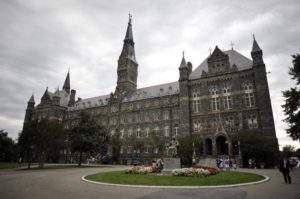
Healy Hall, the flagship building of Georgetown University’s main campus in Washington, D.C., is seen on September 30, 2011. MLADEN ANTONOV/AFP/GETTY IMAGES
In an effort to address its slave-holding past, Georgetown University will offer an admissions advantage to the descendants of 272 enslaved Blacks who were sold in 1838 to keep the institution financially afloat.
University president John J. DeGioia announced the unprecedented move Thursday afternoon during a speech outlining the measures of the new program, The New York Times reports. In addition to the admissions curve, DeGioia said he plans to issue a formal apology, create a learning institute dedicated to the study of slavery and erect a public memorial in honor of the enslaved people whose toil and labor helped benefit the university.
According to The New York Times, two campus buildings will also be renamed in memory of an enslaved African-American man and an African-American woman who founded a school for young Black girls.
“The most appropriate ways for us to redress the participation of our predecessors in the institution of slavery is to address the manifestations of the legacy of slavery in our time,” DeGioia said in a press release Thursday.
Last year, the university president called together a group of alumni, faculty, students and staff to help research solutions on how to move forward with atoning for the institution’s slave past. Among their recommendations to DeGioia were an apology looking toward reconciliation; the renaming of campus buildings; an effective approach to engage the descendants of enslaved African-Americans; the memorialization of said enslaved peoples; and a renewed investment in campus diversity, among other things.
The only idea DeGioia passed on was the suggestion to develop a scholarship program for the descendants. Instead, he moved to enact an admissions advantage similar to what was already in place for the descendants of Georgetown Alumni.
“I hope that what we’re doing has a lasting impact,” said history professor Adam Rothman, who helped lead the research group. “That what we’re doing now to engage with this history will endure decades from now.”
Georgetown is just one of a dozen universities that has taken action to address its ties to slavery. For instance, Harvard University dedicated a campus building in honor of four enslaved African-Americans who worked the land at the institution. Clemson University took similar action by erecting a series of markers to commemorate the enslaved people who helped build the school into what it is today.
Yet still, Massachusetts Institute of Technology historian Steven Wilder said Georgetown’s efforts to address its slave history goes beyond what any other university has done so far.
“It goes farther than just about any institution,” he told The New York Times. “I think it’s to Georgetown’s credit. It’s taking steps that a lot of universities have been reluctant to take.”
In 1838, the Jesuit-founded university came up on hard financial times. So, former Georgetown presidents Rev. Thomas F. Mulledy and the Rev. William McSherry negotiated the sale of 272 enslaved Blacks to help get the university out of debt. The mass purchase earned the school around $3.3 million in today’s dollars.
According to Atlanta Black Star, the group of enslaved people, which included men, pregnant women, and children as young as 2 months old, were shipped from their home plantation in Maryland down to Louisiana. Working conditions in the Deep South were known to be much worse than in the North.


